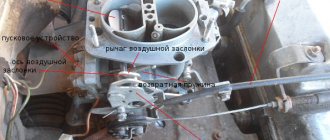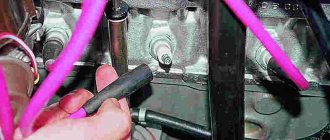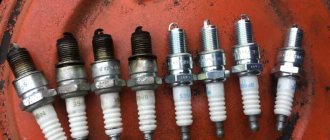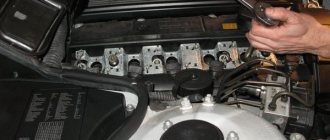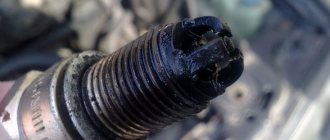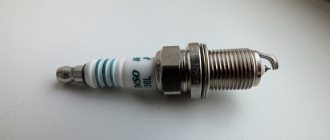When you get into a car and realize that it is impossible to start the engine, you need to find a solution to this problem. Perhaps the only thing is that the spark plugs were flooded. This problem often occurs among drivers in winter. It must be said that the cold season brings a lot of worries. As a rule, the spark plugs are filled with gasoline, but sometimes they are filled with oil.
You must first of all find out what caused this situation. In this case, you can prevent the problem of engine starting in advance. But what if such trouble has already happened? In this case, it is important to know how to get the spark plugs into working condition and start the engine.
How to understand that the candles are flooded
First of all, you need to define the concept of “drenched candles”, that is, what is it? One of the main operating cycles of a gasoline internal combustion engine is the supply of a fuel-air mixture to the combustion chamber and its subsequent ignition. When, for some reason, the spark plug does not light it, this is called “flooding the spark plugs.”
And all because a large amount of fuel gets into the electrodes and the spark plug body. And the more fuel that gets there, the more difficult it is to ignite it, although in practice this is almost impossible until they are dried.
Most often this happens during the cold season, during significant frosts or simply during cold snaps. As drivers say, “in the cold.” During such a period, there is a heavy load on the battery and if it is weak, then there is always the possibility of flooding the spark plugs. That is, the driver tries to start the car two or three times, while the battery is discharged and the spark plugs are filled with gasoline.
However, spark plugs can be filled with more than just gasoline. two other process fluids can get on it - engine oil and coolant (antifreeze or antifreeze).
Indirect signs that the spark plugs are filled with engine oil are the following situations:
- rapid decrease in oil level in the engine crankcase;
- Unstable engine starting, and at any time of the year;
- decrease in the dynamic characteristics of the car, poor acceleration, drop in power;
- Unstable engine operation at idle speed;
- "triple" of the engine.
It is necessary to understand that the listed signs may indicate other breakdowns in the engine, so it is better to unscrew the spark plug/s from its seat and visually assess the condition of its electrodes and insulator. Moreover, it is advisable to check both for the presence of burnt oil and for the general condition. Much can be understood by color.
Similar signs will indicate that the spark plug is filled with coolant (antifreeze). In this case, there will also be a drop in engine power, a rapid drop in the coolant level, and the appearance of white carbon deposits on the spark plug electrodes and/or its insulator. You may also notice the appearance of white smoke from the exhaust pipe.
What does the color of soot deposits indicate?
Using a color shade, you can quickly understand what problem areas are in the engine of your car. However, simply replacing samples will not solve the cause of soot - new spark plugs will very quickly become unusable. Currently, there are 3 main colors of deposits in the ignition system:
Each of the colors presented indicates the occurrence of a specific malfunction or group of problems in the car’s engine.
The appearance of black soot
This plaque can be either dry or oily. The appearance of a black coating in dry form indicates that an enriched mixture is being supplied to the engine. Candles become covered with such soot as a result of:
- Incorrect operation of carburetor systems;
- Clogged air filters;
- High pressure at the stage of fuel supply to the fuel rail;
- Little spark energy;
- Weak compression.
If black oily deposits appear, it is necessary to check the possibility of oil getting into the combustible fuel mixture itself. As a rule, oil leaks as a result of wear of the oil scraper type piston ring set. In addition, the cause of oil deposits can be damage to the valve system caps.
Advice: if you have recently repaired a VAZ-2114 generator, be sure to check the spark plugs. Perhaps some of the problems with the car lie there.
The appearance of white soot
White deposits in the ignition system can have several color shades:
- Slightly ashy colored deposits. Appear as a result of engine operation on low-quality gasoline samples. To solve the problem, you just need to remove and wipe the spark plug rings, after which they will become suitable for use again.
- Shiny white soot. Indicates the appearance of erosion on the body of the contact electrodes. It occurs as a result of overheating of the ignition system, and the cause may also lie in an insufficiently enriched fuel mixture. In addition, problems with early ignition and breakdowns in the cooling system can give such a tint. If the deposits are shiny white, it is best to replace the entire set.
Tip: if the spark appears weakly, a situation may occur when the car jerks when you press the gas pedal. This is also a common cause of a faulty spark plug set.
The appearance of brown or red soot
If red/brown deposits appear, you need to diagnose the fuel mixture entering the engine. Often this situation occurs when a large number of special additives are introduced into the car oil, which flush the engine cooling system. Also, the brown color on the spark plugs indicates that the engine has been running for a long time on a type of leaded gasoline.
As a result of the appearance of a brown conductive coating on the surface of the insulator, you will find disturbances in the normal formation of sparks. The car may not start for a long time and run intermittently at high speeds. To fix the problem, just clean the fuel system by adding new gasoline.
Tip: if there is no spark in the spark plugs, pay attention to the gaps in the electrodes. Perhaps they are covered with carbon deposits. To solve the problem, simply cleaning the spark plugs is not enough - you will need to replace the entire set, since if the situation repeats, problems will arise in the engine.
Why does the candles flood?
The reasons for flooding spark plugs depend on what kind of process fluid they are actually filled with. Let's look at them in order.
Fills candles with gasoline
The most common problem is flooding with gasoline. There are most often 3 reasons for this situation.
Low battery charge
If the spark plugs are filled with gasoline “when they’re cold,” then most often a discharged battery is to blame. This can happen in different conditions, both in the warm season and in the cold. However, in winter this happens more often, since in the cold the battery loses some of its capacity and discharges faster.
With each turn of the key, fuel is injected, but when the spark is weak or completely absent, the spark plugs are filled with more and more fuel by such actions. Such a candle is guaranteed not to give a spark until it is dried.
Fuel failure
Carburetor engine
In older carburetor engines, the reason that the engine fills the spark plugs with gasoline may be due to incorrect settings of the carburetor itself. As you know, this unit requires fine tuning, and over time this tuning may get lost. The carburetor simply pours too much fuel into the cylinders, and it does not have time to ignite. In the warm season, with this setting you can still start the engine, but in cold weather this can become a problem.
Injection engine
In injection engines, the ECU (electronic control unit), which operates based on information from several sensors, is responsible for the amount of gasoline supplied. As the temperature drops, it commands more fuel to be supplied through the injectors to enrich the air-fuel mixture. Thus, starting and the amount of fuel supplied completely depends on their serviceability. Responsible for cold starts are the coolant temperature sensor, TPS, IAC and air flow meter.
For cars equipped with an absolute pressure sensor (MAP sensor in English), this sensor is also responsible for the fuel supply, so its failure leads to flooding of the spark plugs when there is a spark. Often, the Check Engine warning light on the panel lights up, and using an error scanner you can read errors P0106, P0107, P0108, P0109.
If the spark plugs are poured while hot, then the reasons may be: bad/faulty spark plugs (breakdown, gap violation), breakdown of explosive wires or other elements of the ignition system.
Fuel with condensate
When temperatures change, condensation (water droplets) forms. Also, water in gasoline can get into the tank and at the gas station. Water naturally does not burn, and gasoline with such an admixture does not ignite well. To avoid such a situation, fuel dehydrators are used in winter and autumn.
Fills candles with oil
Less common, but also more dangerous, is filling the candles with oil. This is caused by more significant breakdowns of individual engine components. Oil can enter the cylinders (on the electrode and threads) either through the rings or through the valves. When the spark plugs are in oil on top, either the sealing rings of the wells are leaking or the valve cover gasket is leaking.
Valve guides
If the working surfaces of the valve guides are significantly worn, their play may occur. Specifically, between the valve stem and the valve guide. Because of this, oil can flow from the cylinder block directly into the combustion chamber onto the spark plugs.
The situation can become more complicated if this is not the first such case when the bushing comes out of the body of the head. Typically, in such situations, a repair sleeve is used instead of a regular one, since it has a larger diameter. But if regular bushings were installed instead of repair bushings, then all this together leads to the consequences described above.
Valve seals
As for valve seals, they can leak oil into the combustion chamber for various reasons. Among them:
- Increasing the rigidity of the crimping part of the seals. For normal removal of oil, they must be relatively soft. Tanning often occurs due to natural aging or frequent overheating of the engine.
- Failure of the crimp spring. It can stretch significantly, become damaged, or simply jump off the oil seal body.
- The oil seal itself has risen significantly from the body of the guide sleeve.
- If the bushing has significant wear, the valve may tilt to one side. Accordingly, on the opposite side, oil can leak from the cylinder block into the combustion chamber.
As a rule, in the situations described, oil gets not only onto the electrode, but is also located at the beginning of the spark plug mounting thread.
Piston rings
Wear of the piston rings automatically leads to oil leakage from the crankcase into the combustion chamber. In addition to simple wear, a situation is possible when the ring (rings) simply burst, which renders it virtually unusable. Or it’s simply stuck, here you can try to decarbonize it. When checking piston rings, it is advisable to check the compression in the engine cylinders.
Clogged oil system ventilation
The VKG system ensures normal oil consumption on a working engine. When it becomes clogged, the pressure of the crankcase gases increases, which leads to the fact that the piston rings will not cope with their tasks, which is why some of the oil will enter the combustion chamber.
Intake manifold gasket
Some cars have their own “childhood diseases” that appear specifically on them. For example, Renault Megane 2 spark plugs may be filled with oil due to a broken intake manifold gasket. However, this can happen on other machines as well.
Oil in spark plug wells
Not all cars have spark plug wells, but for example, on a VAZ-2112 with a 16-valve 1.6-liter engine, on Priors, Focuses, and Chevrolets, spark plug wells filled with oil are a very common occurrence. The reasons why oil may end up in the spark plug well may be as follows:
- poor valve cover seal;
- wear of sealing gaskets of spark plug wells.
The spark plugs are filled with antifreeze
The reasons why the spark plugs are filled with antifreeze are completely similar to the reasons why the antifreeze itself gets into the engine oil. Let's briefly list them:
- Damage (burnout) of the cylinder head gasket. Occurs from aging, mechanical damage or overheating.
- Violation of cylinder head geometry. The popular name is “moved its head.” The situation arises mainly due to significant overheating of the motor.
- Damage to the cylinder block. In particular, cylinder walls, the appearance of microcracks.
Oil in spark plug wells: cause of malfunction and possible consequences
Note that the appearance of oil in the area of the spark plug well is quite common on different internal combustion engines. Next, we will look at the problem using the example of 16-valve engines that are installed on the domestic Lada Priora model.
It should be separately added that such a problem can arise both on used cars and on practically new ones. In this case, this malfunction should be corrected immediately, since oil getting into the wells can lead to more serious complications.
If oil is present in the spark plug well, then this leads to softening of the rubber elements (spark plug insulator, high-voltage armored wires). As a result, spark breakdowns, cylinder misfires occur, the engine starts poorly, stalls, and loses power. In the future, various elements of the ignition system (coil, spark plugs, etc.) may fail.
Such failures can cause the engine “check” to light up on the dashboard, the engine requires constant computer diagnostics and error reset, not to mention the reduced service life of the spark plugs themselves, explosive wires and other parts.
So let's get back to the reasons. To begin with, oil usually enters the spark plug wells through leaks in the valve cover gasket area or through the spark plug well seals. On many engines, a rubber gasket is installed under the valve cover for sealing, and various types of sealants (anaerobic, silicone, etc.) have also recently become widespread.
Gradual drying of the sealant, errors in its application, as well as the use of low-quality compounds lead to the fact that such a seal begins to leak, much faster than a conventional gasket. Owners of the Priora model noted cases when oil appeared in the spark plug wells even on new cars. The fact is that during the long period of inactivity of the car in the car dealership, the sealant simply had time to dry out.
What to do if the candles are flooded
Measures to eliminate the malfunction directly depend on the reason why the engine is flooding them. Let's look at them in the same order.
When filling with gasoline
The first thing you can do is purge the cylinders for 10 seconds by opening or partially opening the throttles, making the mixture lean. You can also unscrew the spark plugs and clean, burn out (dry), and also check the gap and any other visible damage. It would also be a good idea to have a multimeter on hand to check the voltage at the battery terminals, it may be too low.
Do not attempt to start the engine again until the problem has been repaired. This way the candles will be filled even more.
How to start the engine if the spark plugs are flooded:
- If you fail to start the engine a maximum of the third time, then you need to wait about 5...10 minutes and then repeat the operation.
- Charge the battery or try to “light it” from another car.
- Unscrew the flooded spark plugs and replace them with a spare set. If it is not there, then you need to dry the spark plugs and check the condition of the electrodes, insulator, and metal.
- Try to start the engine with an already charged battery and dry spark plugs.
There is also a method on how to start the engine when the spark plugs are flooded. However, to implement it, you need a well-charged battery . So, when starting, you need to press the accelerator pedal all the way down and at the same time try to start the engine. On cars with a manual transmission, it is also advisable to depress the clutch to facilitate starting.
This is done so that the air that passes through the cylinders dries the spark plugs a little. And accordingly, the more air there is, the better the drying process will occur. On injection engines in this mode, the computer control system turns off the excess fuel supply and the spark plugs dry. As for carburetor engines, in a similar mode they do not create excessive pressure in the cylinders, but, on the contrary, a slight vacuum appears. This physical condition can also dry out the spark plugs a little and “squeeze” gasoline out of them.
If there is gasoline with water, then there are two ways to proceed. The first is to completely drain the low-quality fuel, flush the fuel system and fill in with new, high-quality gasoline. Another option is to use special moisture removers. These products are designed to neutralize the condensate present in gasoline. However, they are able to cope with only a small amount of moisture, so you should not expect a miracle from them.
When the problem is in the sensors or electrics, you won’t be able to start the engine until the faulty element is eliminated. True, whatever the reason, you shouldn’t suffer every morning - you need to look for and eliminate the cause!
When filling candles with oil
As we have already found out, it can be filled with oil both from below and from above. If you have oil in the wells (the insulator has flooded), then the first step is to remove the lubricant. This can be done with a syringe or a paper rag. How the problem itself is eliminated depends on the situation. Either change the gasket or seal it with sealant.
Throws oil at the electrode or candle thread - you can, of course, burn it out on the fire, but this will not solve the problem itself. If there is a strong oil leak into the cylinder you will not get very far; you need to eliminate the cause: change the seals, valve guides, or rebuild the engine and change the rings.
So, if there is a problem with the guides, it is necessary to replace them with a repair option. If this is done repeatedly, then you need to look at the diameter and select it based on the specific situation. If necessary, it is better to seek help from a car service center.
If oil oozes due to wear of the seals, then there are two possible repair options. The first is replacing valve seals. However, this option is only possible if the valve bushings are not very worn. Otherwise, new oil seals will similarly quickly fail. Therefore, the second option is to completely replace the guide bushings.
If there is significant wear on the valve guides, then it is necessary to replace both the valves and the guide bushings.
If piston rings fail, they must be thoroughly diagnosed. The fact is that the valves often fail with the rings, and the inner surface (mirror) of the cylinder is also damaged. If only the rings fail, they need to be replaced. If there are problems with the surface of the cylinders, then you can try to sharpen them. As for the valves, you need to look at their condition. Often they are also replaced with new ones.
If there is a high oil level in the crankcase, then you need to drain it to the MAX mark on the dipstick. However, if the mentioned level has risen due to antifreeze getting into the oil, then a large list of work must be performed. In particular, completely drain the oil, eliminate the cause of the breakdown due to the mixing of lubricating and cooling fluids, flush the cooling and lubrication system, and only then fill in new process fluids into the mentioned systems.
If the crankcase ventilation system is clogged, it is necessary to find and eliminate its cause. The test depends on the design of the system itself. Usually you need to check the pipes, oil separator, PCV valve.
If the intake manifold gasket has failed, then it only needs to be replaced with a new one. Naturally, you need to clean spark plugs and other elements from any motor oil that has gotten on them. A candle, for example, can be cleaned using a sandblaster.
When filling spark plugs with antifreeze
Most often, antifreeze appears in the oil due to the cylinder head gasket burning out or the geometry of the “head” being damaged. In this case, you just need to change the gasket and grind the surface, otherwise the problem will not be solved.
If the geometry of the engine cylinder head has been damaged, you need to contact a car service center for help. There, with the help of special machines (milling, grinding), craftsmen will restore its normal shape, in particular, the lower plane.
If the heat exchanger or its gasket is damaged, in most cases it is necessary to replace these elements, since they are practically irreparable.
In rare cases, not only the head, but also the cylinder block itself can change the geometry. This is a rather complicated case, and you need to seek help from a car service center. There, using special equipment, you can try to restore it. But, unfortunately, this is not always possible. Especially if the engine is old, has a high mileage, or is mechanically deformed, for example, due to an accident.
In older cars, antifreeze can get into the oil, and from there into the spark plugs due to leaking pipes and/or connecting clamps. However, in this case it is impossible to give specific advice, since it depends on the design of the particular car and the condition of its engine (rubber pipes).
However, the spark plugs are filled with antifreeze - this is the least that will happen in case of such a malfunction.
Self-fixing oil leaks in spark plug wells
Taking into account the above information, it becomes clear that for normal operation of the ignition system, even a minor leak that leads to oil accumulation in the well area must be eliminated. However, not all drivers know what to do if there is oil in the spark plug wells. Let's look at how to remove oil from spark plug wells and make such repairs yourself.
Let us immediately note that although this procedure is not complicated, without certain skills it will still be correct to contact a service center and entrust the car to specialists. If you solve this problem yourself, then you will need:
- remove the intake manifold;
- remove the timing belt casing;
- remove the timing belt;
- remove the valve cover;
- remove the camshaft from the bed;
These works will allow you to gain free access and fully remove the old layer of sealant from elements and surfaces, as well as efficiently apply a fresh compound. Please note that it is imperative to completely remove the old sealant. Any residues may interfere with subsequent sealing of parts using the new composition. In this case, the entire complex of work will need to be carried out again.
As a result, the oil leak will continue, additional air leaks may appear, etc. For this reason, the old sealant is removed with chemical solvents. For this, use acetone, white spirit or regular gasoline. A small piece of cloth is soaked in a solvent, after which the surface is thoroughly wiped off to remove the old sealing compound.
Fresh sealant is then applied to the surface of the valve cover and reassembled. As for the sealant itself, the best option for these purposes is an anaerobic sealant. During assembly, it is also important to consider the order and tightening torque of the mounting bolts when installing the valve cover.
Cleaning
If the spark plugs are dirty, then it is not at all necessary to immediately replace them with new elements of the ignition system, igniting the fuel mixture in the combustion chamber of the VAZ 2110. Regular cleaning will quickly remove the dirt and return the spark plugs to their previous functionality.
There are several common cleaning methods that can be used at service stations and in garages with your own hands.
Regardless of the chosen method, we recommend that you follow the general principles of operation when cleaning the elements of the ignition system.
- Protect the coating of the spark plugs from abrasion; do not use rough sandpaper or other similar abrasives.
- Do not expose the candle to high temperatures. It is not worth heating them over a fire for the purpose of cleaning. Some people do this for some reason.
- Check the spark plug for resistance using a megometer. If the second scale does not show + infinity, then the spark plug will have to be changed. Cleaning is useless. With a value of 1000 it is also better not to try to resuscitate the element.
Now let's talk directly about cleaning methods.
Cleaning before and after
The formation of carbon deposits and flooding will require not only removing and drying the spark plugs, but also thoroughly cleaning them.
- One popular method is to remove carbon deposits with a fine-bristled wire brush;
- Another option is treatment with kerosene, which removes carbon deposits quite effectively;
- Another method involves the use of sandblasting. The effectiveness of this approach is short-term, so you will soon have to remove the candles again and clean them;
- Many people have also gotten used to using chemical converters. To do this, candles are placed in a solution, allowed to sit for about an hour, after which they are cleaned with matches, toothpicks to remove carbon deposits, washed with water and dried;
- In order not to buy specialized products, you can use acetone using the same cleaning principle;
- Our grandfathers cleaned candles with vinegar. To do this, you will need to dip them in vinegar for an hour, then add literally 5 drops of electrolyte;
- There is an ultrasonic cleaning method, but this requires specialized equipment.
Article on the topic: Diagnostics and replacement of the fan sensor on a VAZ 2114
If you do not get the desired result, you will have to change the candles. But first they need to be selected.
Tags
appearance of oil in oil appearance of oil in contact with oil oil level in the ability of oil to pass oil into the ability of oil to get into valve stem seals presence of oil on Motor oil Motor oils Motor oils Motor oils Motor oils Motor oils Motor oils in engine oils Motor oils Motor oils allow oil to pass into valve stem seals valve stem seals
motormaterialssystemsealantventilationcleanersgetadditivescolorsituationcartransmissionspecialvas

